Monitoring and management of strawberry aphid research results
Learn research results from a study on the habits of strawberry aphids.
Strawberry viruses have recently been identified as a major problem in Ontario and northeastern America.
Strawberry aphids, Chaetosiphon fragaefolii, are known to be an important vector of several strawberry viruses: strawberry mild yellow edge (SMYEV), strawberry vein banding (SVBV), strawberry mottle (SMoV) and strawberry crinkle virus (SCV). Strawberry aphid can be distinguished from other aphids found on strawberries by its knobbed hairs, visible with magnification (Figure 1). Information about strawberry aphid, its life cycle, overwintering methods, and the timing of population build-up and dispersal, is needed to develop pest management plans for aphid and virus control.
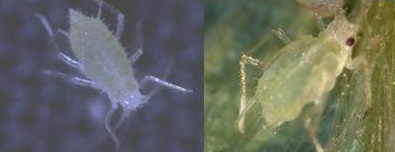
The greenhouse whitefly has been recently identified as a vector of strawberry pallidosis virus (SPaV) . We have little or no information on this pest in Ontario strawberry fields.
A project to address these information gaps was developed with funding from the Undergraduate Student Experiential Learning Program, a collaborative program between OMAFRA and the University of Guelph.
Summer students collected leaf samples and counted aphids at 15 strawberry farms throughout the summer. In Simcoe, sticky traps and bowl traps were tested to assess the flight period of winged aphids and monitor their dispersal.
What we learned:
- At least some strawberry aphids overwinter as eggs. Shiny black eggs (Figure 2) were found on lower leaves of overwintering strawberry plants in late April, and most eggs had hatched by early May.
- Strawberry aphids are present throughout the season, from early May to end of August (Figure 3).
- Aphids developed wings and the ability to disperse from field to field in early to mid-June. (Figure 4)
- Bowl traps (Figure 5) and sticky traps (Figure 6) were effective, but inconvenient tools for monitoring aphid flight in general (Figure 7). It was difficult to identify the aphid species caught in these traps. Monitoring strawberry foliage provided a better indication of when first winged aphids developed, and when dispersal could begin.
- Most ( 80%+) aphids found on strawberries are the strawberry aphid, Chaetosiphon fragaefolii. Two other species of aphids were found in lower numbers, towards the end of the season. These have been sent to Agriculture And Agri-Food Canada for identification to species.
- New plantings are at high risk for strawberry aphids throughout the season. While we expected to see aphids in May and June, we were surprised to see such high numbers of aphids on new growth in these fields in late summer (Figure 8).
- Whiteflies were not observed in fields during the spring and summer. However, since late September, whiteflies have been observed in several strawberry fields.
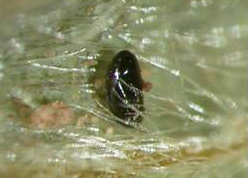
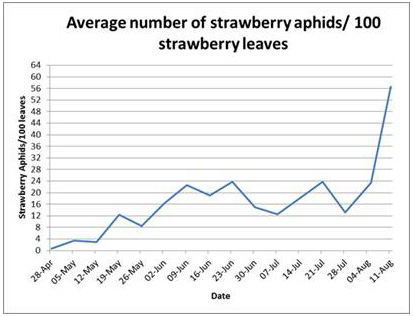
Accessible image description for Figure 3
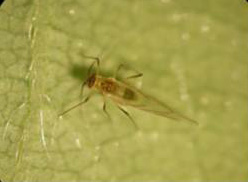
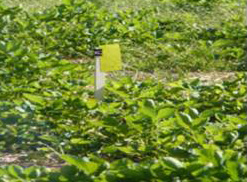

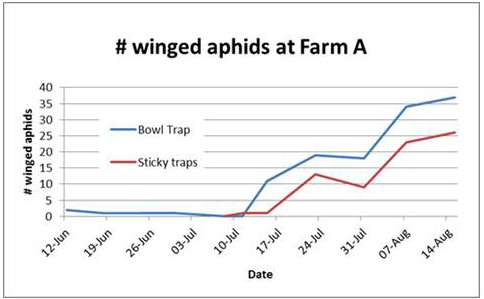
Accessible image description of Figure 7
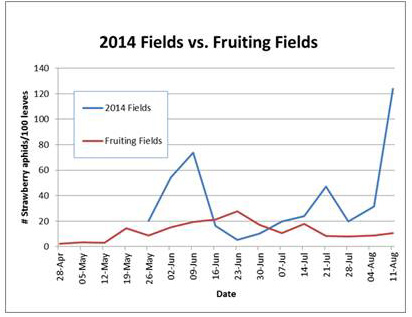
Accessible image description of Figure 8
Accessible image descriptions
Figure 3. Average strawberry aphid population from fifteen farms.
Chart showing the average number of strawberry aphids from fifteen farms from April 28 to August 11, 2014. Sample size was 100 strawberry leaves. Number of aphids rose on May 19, June 9, June 23, July 22 and a significant rise on August 11.
Figure 7. The number of winged aphids found in bowl and sticky traps at one farm.
Chart showing the number of winged aphids found in bowl and sticky traps at one farm from June 12 to August 14, 2014. Numbers in bowl traps remained steady until July 10 when they continued to rise until August 14. Numbers in sticky traps remained steady until July 14 and then continued to rise until August 14.
Figure 8. Strawberry aphid populations in fruiting fields compared to newly planted 2014 fields.
Chart showing strawberry aphid populations in fruiting fields compared to newly planted 2014 fields. Using data from nine 2014 fields and 17 fruiting fields. Aphid populations in fruiting fields remained steady with a light increase mid-June. Aphid populations in newly planted field showed a short incline at the beginning of June and then again at mid-August.